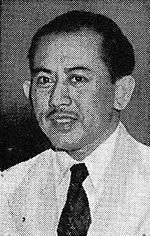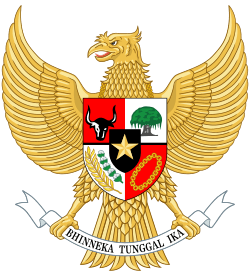Mohammad Roem
Mohammad Roem ([moˈhamad ˈrʊm]; 16 May 1908 – 24 September 1983) was a diplomat and one of Indonesia's leaders in the Indonesian war for independence. During the Sukarno presidency, he served as Deputy Prime Minister, Foreign Minister, and later Minister of Home Affairs. He was most notable for his part in the Roem–Van Roijen Agreement during the Indonesian revolution.
Mohammad Roem | |
|---|---|
 Mohammad Roem, c. 1950s | |
| 4th Foreign Minister of Indonesia | |
| In office September 6, 1950 – March 20, 1951[1] | |
| President | Sukarno |
| Preceded by | Agus Salim |
| Succeeded by | Achmad Soebardjo |
| 4th Interior Minister of Indonesia | |
| In office October 2, 1946 – June 27, 1947[1] | |
| President | Sukarno |
| Preceded by | Sudarsono |
| Succeeded by | Wondoamiseno |
| In office November 11, 1947 – January 29, 1948 | |
| President | Sukarno |
| Preceded by | Wondoamiseno |
| Succeeded by | Soekiman Wirjosandjojo |
| In office April 3, 1952 – July 30, 1953[1] | |
| President | Sukarno |
| Preceded by | Iskak Tjokrodisurjo |
| Succeeded by | Hazairin |
| Personal details | |
| Born | May 16, 1908 Temanggung, Central Java, Dutch East Indies |
| Died | September 24, 1983 (aged 75) Jakarta, Indonesia |
| Nationality | Indonesia |
Early life
Roem was born in Parakan, Temanggung, West Java, on 16 May 1908. His father's name was Dulkarnaen Djojosasmito, and his mother's name was Siti Tarbijah.[2] He moved to Pekalongan because Parakan was hit by an outbreak of infectious diseases like cholera, plague, and influenza.[3] In 1915, he studied at Volksschool and two years later continued to Hollandse Inlandsche School until 1924.[4][5] In 1924, he received a scholarship to study at the School tot Opleiding van Inlandsche Artsen ("school for the training of native physicians", STOVIA) after attending government examinations.[5] Three years later, he completed the preliminary test and was transferred to Algemene Middelbare School, and graduated in 1930.[6] After attending the admission test of Medical College, and was rejected, he turned to law, entering Rechts Hoogeschool in 1932 and obtained the degree Meester in de Rechten in 1939.[7][5]
Career
During the Indonesian national awakening, he was active in several organizations such as Jong Islamieten Bond in 1924 and Sarekat Islam in 1925.[8] During the revolution, he was a member of the Indonesian delegation at the Linggarjati Agreement (1946) and Renville Agreement (1948). In 1949, he was also the leader of the delegation at the Roem–Van Roijen Agreement, that discussed Indonesia's borders, and which was signed on May 7, 1949.[9]
As a state official, he served as interior minister in the Sjahrir III Cabinet, foreign minister during the Natsir Cabinet, interior minister during the Wilopo Cabinet, and deputy prime minister during the Ali Sastroamidjojo II Cabinet.[1]
Prison
Roem was a senior figure in the Masyumi Party, which was banned by President Sukarno in 1960 for its support of the PRRI rebellion. In 1962 he was arrested and jailed without trial in Madiun, together with Sutan Sjahrir, Anuk Agung, the sultan of Pontianak Hamid and Soedarpo Sastrosatomo. They were released by attorney-general Sugi Aito in May 1966.[10][11][12]
Personal life
Roem married Markisah Dahlia in 1932. They had two children; a boy, Roemoso, born in 1933 and a girl, Rumeisa, born in 1939.[5]
Death
Roem died in September 1983 from a lung disorder, leaving a wife and two children.[13]
References
- Detail Biodata Pejabat Menteri Archived 2011-07-23 at the Wayback Machine at kepustakaan-presiden.pnri.go.id (in Indonesian)
- Insaniwati 2002, p. 1
- Insaniwati 2002, p. 4
- Insaniwati 2002, p. 7
- Kahin 1984, p. 135
- Insaniwati 2002, p. 8
- Insaniwati 2002, p. 9
- Insaniwati 2002, p. 14
- "Australia & Indonesia's Independence:The Transfer Of Sovereignty: Documents 1949".
- Almanac of Current World Leaders, Volume 9, 1966. p.132
- Ricklefs 2008, p. 420.
- Madinier 2015, pp. 428-429.
- "Roem dies of lung disorder". The Straits Times. 26 September 1983.
Bibliography
- Insaniwati, Iin Nur (2002). Novita, Ita Dian (ed.). Mohamad Roem: Karier Politik dan Perjuangannya, 1924–1968 [Mohamad Roem: His Political Career and Struggle, 1924–1968] (in Indonesian). Magelang: IndonesiaTera. ISBN 978-979-9375-51-3.CS1 maint: ref=harv (link)
- Kahin, George McT. (April 1984). In Memoriam: Mohamad Roem (1908–1983). Indonesia. 37. Ithaca, New York: Cornell Modern Indonesia Project. pp. 135–138.CS1 maint: ref=harv (link)
- Madinier, Rémy (2015). Islam and Politics in Indonesia: The Masyumi Party between Democracy and Integralism. Translated by Desmond, Jeremy. Singapore: NUS Press. ISBN 978-9971-69-843-0.
- Ricklefs, M.C. (2008) [1981], A History of Modern Indonesia Since c. 1200 (4th ed.), Palgrave MacMillan, ISBN 978-0-230-54686-8
| Political offices | ||
|---|---|---|
| Preceded by Sudarsono |
Interior Minister of Indonesia 1946–1947 |
Succeeded by Wondoamiseno |
| Preceded by Wondoamiseno |
1947–1948 |
Succeeded by Soekiman Wirjosandjojo |
| Preceded by Iskak Tjokrodisurjo |
1952–1953 |
Succeeded by Hazairin |
| Preceded by Mohammad Hatta |
Foreign Minister of Indonesia 1950–1951 |
Succeeded by Achmad Soebardjo |
